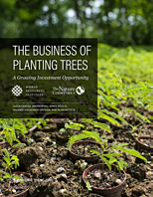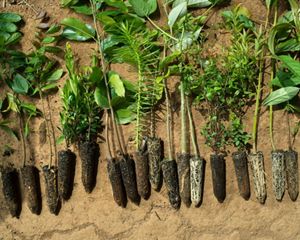The Business of Planting Trees
A Growing Investment Opportunity
By Lynn Scarlett, Former Chief External Affairs Officer

Approximately 41 million trees are cut down every day—far faster than we are currently replanting them. The consequences of deforestation and other types of land degradation are severe, exacerbating climate change, biodiversity loss, and declines in ecosystem services that hundreds of millions of people depend on.
In response, governments around the world have committed to restore 160 million hectares—an area larger than South Africa. But it will take more than government action to execute on these commitments; the private sector has an important role to play, too.
In fact, these commitments are spurring increased demand for companies that can deliver large projects cost-effectively—restoring degraded land has the potential to become a big business opportunity, on top of providing much needed climate mitigation and other ecosystem benefits. Established companies and entrepreneurs alike are finding new ways to make money from sustainably managed forests and farms.
Some are responding to governmental incentives; others are responding directly to the market, restoring land to generate new products and services, or to differentiate their offerings from the competition. Some entrepreneurs are betting that a huge new business opportunity for natural carbon capture and sequestration will emerge as more governments charge a fee for emissions driving climate change. New research by The Nature Conservancy, World Resources Institute and other partners shows that restoration and other land management improvements could provide more than a third of the emissions reductions necessary to keep global warming under 2°C.
Yet hurdles remain, and one of the biggest is funding. Many investors still know little about restoration opportunities. This report is intended to bridge that information gap; it includes case studies of 14 innovative enterprises across eight countries. They cover a fascinating range of activities, from drones that shoot seeds into hardened soils to genetic research on tree species threatened with extinction.
The restoration economy is at the take-off stage. New business models are emerging, technology is advancing and governments are showing political will. This is great news for investors looking for the next growth opportunity. And this is good news for the planet, since restoring land can provide clean water, improve livelihoods and enhance biodiversity—all while pulling back to the earth excess atmospheric carbon that would otherwise be heating the planet.
Opportunities have never been greater—and the task has never been more urgent. As an ancient Chinese proverb says, “The best time to plant a tree was 20 years ago. The next best time is now.”
For media inquiries, contact media@tnc.org.
The Executive Summary is also available in Spanish, French and Portuguese.
Global Insights
Check out our latest thinking and real-world solutions to some of the most complex challenges facing people and the planet today.




